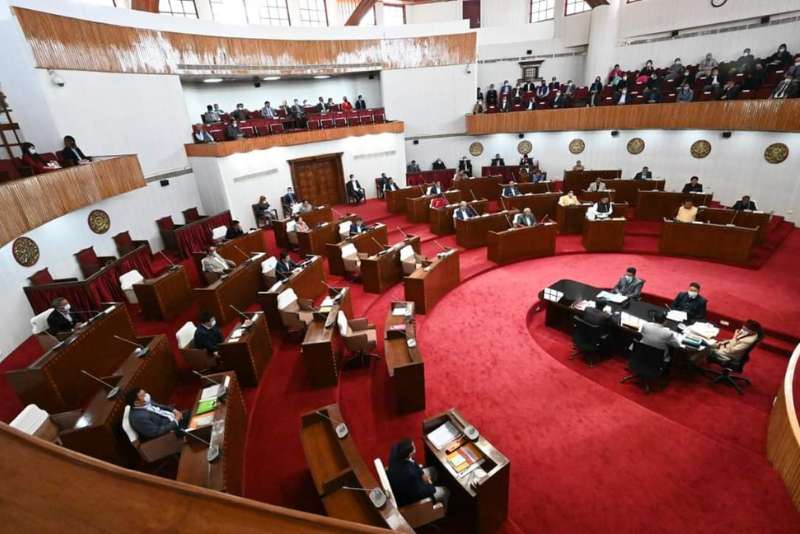
Gangtok: The recent Glacial Lake Outburst Flood (GLOF) in Sikkim, which occurred on October 3, 2023, has left a profound impact on the state, prompting legislators to raise concerns about the safety and future of the Teesta basin in the Sikkim Legislative Assembly session.
Extensive Damage and Casualties
The GLOF event primarily affected the constituencies of Mangan-Lachen, Dzongu, and Kabi Lungchok in the Mangan district. However, the most significant casualties were reported in West Pendam, where the floodwaters took a toll on lives and properties.
Urban Development Minister LB Das, representing West Pendam constituency, revealed that more than 1500 houses were damaged between Golitar near Singtam and Rangpo, along a 10-12 kilometer stretch of National Highway 10 (NH 10). In a somber address to the Assembly, Das raised a pressing concern: “The government should examine if the Teesta and Rangit riverine areas in Sikkim are safe for human settlements or go to the extent of declaring it as a ‘no construction zone.'”
Highlighting the severity of the situation, Das added, “We have seen the wrathful look of the Teesta River, and I feel that river training or protective works cannot withstand it. Besides multiple casualties, hundreds were displaced after their houses were fully or partially submerged by the floodwater and slush.”
Timely Warnings and Response
Despite the grim circumstances, timely warnings and effective responses played a crucial role in mitigating the disaster’s impact. Das noted that the police and local administration promptly sounded warnings around 1 a.m. on October 4 in the low-lying areas of his constituency. “Police gave a timely warning through microphones and messages that led to the safe evacuation of the people. If it was not done timely, the casualties from our constituency would be around 3,000-4,000, but minimum casualty took place,” said West Pendam MLA.
During the subsequent relief and restoration efforts in Rangpo, authorities discovered that around 24 buildings were constructed above drains in violation of government rules.
Reevaluating Construction Near Rivers
Forest Minister Karma Loday Bhutia emphasized the need to reevaluate construction near the Teesta and Rangit rivers. Bhutia, who represents Kabi Lungchok, raised questions about the past decisions to allow residential buildings and pharma factories along the riverbanks, asking, “Whose fault was it to allow construction of residential buildings and pharma factories along the river banks? Does it have to be our government to correct the past mistakes?”
Bhutia also mentioned certain illegal constructions on the riverbeds, revealing that the Forest Department had already initiated actions against them.
Ignoring Warnings
Dzongu MLA Pintso Namgyal Lepcha pointed out that over the years, people had become desensitized to warnings about the Teesta River overflowing. “For years, the glacial lake outburst warning had been given, but people over the years have become accustomed to such alerts. When the alert had been given that night, many considered it as a routine matter and believed that it (flood) wouldn’t happen,” said Pintso Namgyal.
The low-lying areas of Dzongu also experienced a significant loss of life and property, with two main bridges connecting Dzongu to the rest of Sikkim being washed away at Phidang and Sangakhalang.
Demand for Accountability and Preparedness
Sikkim’s Bharatiya Janata Party President, Dilli Ram Thapa, representing the unaffected Upper Burtuk constituency, strongly criticized the government for failing to declare the October 3 disaster as either a ‘natural disaster or mistake.’ In his condolence message, Thapa called for accountability, stating, “The souls of the 42 lives lost in the October 3 GLOF would not find peace until it was determined if their deaths were the result of a natural disaster, institutional lapses, or mistakes by the elected representatives.”
Thapa highlighted that multiple agencies had warned about the GLOF threat since 2001, with the Supreme Court of India directing the installation of early warning systems for hydroelectric plants. “We had 22 years to work on GLOF management but all we did was to install 2-4 pipes to drain the lake water from South Lhonak. There has been a huge mistake from us, the leaders. It is now time to act responsibly, as there are many more glacial lakes under threat in Sikkim,” he said.
Thapa suggested forming a joint delegation of legislators led by the Chief Minister to make representations to the Prime Minister of India and the Home Minister in Delhi for the allocation of more funds, highlighting the significant economic loss to the state in the aftermath of the October 3 GLOF.
Also Read: Bhaichung Bhutia Criticizes Sikkim CM’s Response to Glacial Lake Outburst
Gangtokian Web Team, 03/11/23

















































